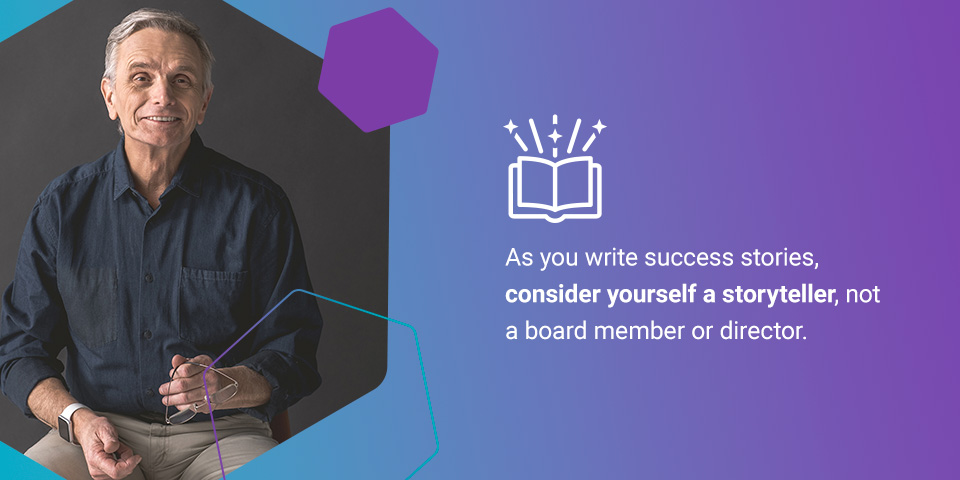Feb 1, 2024
Why Donors Love Success Stories

When someone decides to donate to your organization, two crucial elements must come together — their understanding of the problem and a belief that they can make a difference. Donor success stories establish these elements and can appeal to new donors and existing ones, but how do you craft these compelling and heartstring-tugging stories? It starts with knowing why they are important and building a story around those goals.
Why are Success Stories Important?
Some of the top reasons donors stop giving include a lack of valuable information or feeling like their donations aren’t appreciated. Understanding the impact helps at all donor levels. Success stories communicate that impact, help the donor connect with your cause, and empower them to do more. Some of the benefits of donor success stories for fundraising include:
- Showing donors their gifts will make a difference. Success stories are inspiring, and they reassure donors or potential donors their funds make a real impact. They see people they relate to in situations that drive empathy — all while seeing how your organization can turn their dollars into action.
- Preventing donor fatigue. Recurring donors who only hear about the severity of the problem often get fatigued by the requests, which can be emotionally exhausting. If they occur too much, your donors could start to wonder if their money is even helping. Sharing positive effects can balance these stories of need with some inspiration.
- Providing context about beneficiaries. Donors may not have a good picture of the people they’re helping, especially if they’re far away. Success stories show real accounts, adding depth and dignity to a donor’s understanding of beneficiaries. They can prevent beneficiaries from being seen as numbers and educate donors on real-world situations.
- Builds your organization’s brand story. Success stories are opportunities to discuss what makes your organization effective and unique. You can incorporate your tone and values throughout the messaging and show connections to your mission statement.
- Strengthening your connections with beneficiaries. Making a success story can also solidify relationships with the person you’re writing about. During interviews, you often ask questions that make them think deeply about their connection with the organization and their impact. Many will increase their donations and support for your cause.
Success stories go hand-in-hand with stories that discuss the problem. If you only share one or the other, you might not spur your donors to action. Only sharing problems is exhausting and discouraging, but only showing successes can make it seem like there’s no need for more support. Balance these two complementary topics to share the problem and make your audience feel empowered to fight it.
Engage Your Donors with Success Stories
Making effective success stories requires a little creativity, a good formula, and a clear goal. Put your donors front and center, and craft an engaging experience. Keep these tips in mind as you write and plan your fundraising success stories:
1. Prioritize emotions over logic
If you’re involved in your organization’s administrative team, you’re probably immersed in statistics and reports about your work. While a well-placed statistic is often helpful in quantifying your capabilities, don’t focus on logic and numbers in your success stories.
Instead, aim for an emotional pull — help your donors connect with the human element. When using statistics and data, always bring it back to the main idea to maintain the emotional thread throughout the piece. Wrap up your story with an emotional call to action and a clear donation request.

As you write success stories, consider yourself a storyteller, not a board member or director. If you’re not sure where to start, explore our guide on improving storytelling.
2. Make your story engaging and easy to read
Success stories can take many forms, from brief snippets on social media to long, detailed blog posts or whitepapers. You might even use video or audio, such as podcasts, to share these stories. Regardless of the channel, keep your content engaging. Use conversational language and leave out any unfamiliar jargon.
These stories are a great opportunity to show your organization’s personality. Make it feel authentic and transparent. If it’s appropriate, you could even add some humor. A conversational tone makes the story feel human and adds emotion.
3. Help people identify with your cause
Creating a relatable character in fiction does wonders for the story. Similarly, a nonprofit success story that centers around a real human being allows people to connect with them and empathize. Even small similarities, like being around the same age or having kids, can help people connect with beneficiaries.
You can also use this tactic to reach people outside of your traditional donor demographics. Say you offer services for older adults, but the 20-something grandchild of a beneficiary can speak to how you helped strengthen their relationship. Featuring the grandchild in your story can offer a relatable connection for younger donors.
4. Find good subjects
Half of creating a good story is finding your subject. Spend some time on the front lines, asking beneficiaries, workers, and donors about their experiences. Another good way to find interviewees is to collect surveys and ask if respondents would be interested in sharing their stories in a one-on-one chat.
Remember to get permission from your interviewees or use pseudonyms to keep their information private.
5. Consider the donor’s perspective
Ultimately, your success story should encourage people to donate. Think about how a donor would view it, and answer any questions they might have. Talk to your donors to understand their perspective before creating success stories.
You might ask them about:
- What impact do they hope to have?
- What made them start donating?
- Characteristics of their lives, such as their wealth or family characteristics.
- Why does your cause resonate?
- Why did they choose your organization over others?
Get personal with your questions, and ask about the feelings associated with their contributions. Are they primarily motivated by creating a better future for their kids, or has a life event recently opened their eyes to the problem? Uncover these motivations, and gear your success stories toward them.
Attract and Retain Donors Through Your Donor Management Strategies
Sharing success stories is an important component of donor management, allowing you to show the impact and spur further contributions. As you build your donor management strategy, consider other elements like analyzing data on your donors and sending thank-you letters. These tools can help you learn about your donors and engage them more effectively.
GiveSmart’s fundraising and donor management platform offers a suite of resources for nonprofits and charitable organizations to maximize their results. Request a demo to see our donor management features in action and boost your impact.

Related



